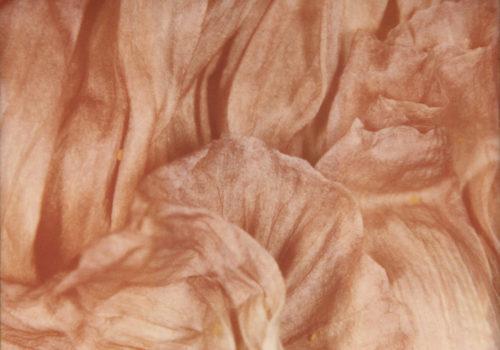“It’s a reflection of time passing and this flower revealed it to me”– Inès Dieleman
The photographer carried out work on poppy flowers in Polaroids which offer a surprising chromatic palette. Published with the publishing house of the 37.2 agency, her book is an ode to plants.
Your book Pavot offers an exploration of the flower photographed with Polaroid from all angles. Can you go back to the genesis of this project?
For me, plants are already a favorite area and express many things from their birth to their death. It turns out that for years I had a dentist’s Polaroid camera that allowed me to do macro photography. I had fun photographing all my friends’ irises with it. One day, I had a bouquet of poppies at the end of their life on a table. And I saw that these flowers wanted to offer me something other than their basic reality of flowers, when they are fresh. I did this series instinctively, like in a trance. It was a magical moment because the flower gave itself up in all its splendor, its sensuality and its magnificent decline.
For a long time this photographic series remained in a drawer. It was my agent, Nicolas Huet Greub, who helped me unearth this work and who convinced me to publish it, and make a book.
Why were you interested in the poppy flower?
It’s a flower that I find very ambiguous and that’s what interests me. It has light, almost transparent petals, like a princess dress, it is voluptuous and at the same time its stem is brutal, like very hairy legs. Its shell evokes male organs, hairy too, and its heart is very graceful, like feminine underwear, like lace. As it ages, when it dries, it reveals something else. It changes in a very personal way like a woman can change, with a new unexpected beauty. It’s a reflection of time passing and this flower revealed it to me.
The shades of the polaroids evolve throughout the book, going from saffron yellow to midnight blue, even going as far as purple tips… How did you achieve these color variations?
I started this work with expired Polaroids. These shades are the result of chance emulsions. The first series of the book is the hottest. The second loses its yellows. The third turns blue-pink. And the last tends towards blue-brown, with parts missing for this emulsion is old.
Jean Santilli who wrote the text speaks of an “aging, withering, sighing flower…” from which nevertheless emerges the beauty of Aphrodite. Has this fragile beauty of the flower and its singular “eroticism” been at the heart of your work?
Yes quite. We can think of Irving Penn, of the work of Robert Mapplethorpe… As for my meeting with the author of the text, Jean Santilli, I owe it to the chance of my deviations in relation to this book. I was originally going to suggest that the actress Charlotte Rampling write the foreword, but she ultimately backed out as she was doing visual work herself. I thought these flowers looked like her. Then I worked with my friend Guido Mocafico who helped me give rhythm to the images, to see them differently. Jean Santilli, I met at a party and he had just finished his work: “Our Lady Goddess & the Feminicide of Heroes”. I was fascinated and without thinking I entrusted him with the project of prefacing the book.
The book alternates between small and large formats of Polaroids. How was the layout designed and, more generally, the object that is the book?
At the beginning, with my friend, artistic director Marine, we laid out the polaroids in a very sparse, almost confidential way. Then, with Guido, we reorganized in a more “botanical” way. Finally, we decided with Marine, by taping all the images around a room, to alternate close-ups and multiple plates. We realized that close-ups really allowed us to feel the presence of the flower, to be in contact with it.
In your work as a photographer, the flower seems an important element. Can you tell us to what extent, why and how you use it?
Plants in general fascinate me. It is moving from its birth to its death and beyond. It always expresses something. It’s perpetual poetry and for me it’s like an escape. It reassures me. I know It will offer me something, exchange with me. It’s a universe of absolute poetry.
The book was published by the 37.2 publishing house, a photography agency founded by Nicolas Huet Greub of which you are a member. The latter wants the agency’s photographers to be able to combine commissioned work and more personal work, hence the idea of publishing projects like this?
Yes absolutely. we of course do commissioned work which allows us to feed this type of project. In our industry, agencies need our free perspective to open creative doors for advertising campaigns. Especially when working for luxury brand which is our favorite territory. We are fortunate that this field of expression is in demand for new openings and photographic directions. For agencies, the fact that we are photographers who express themselves is a reference beyond the technical requirements of advertising campaigns.
Are you working on another book project?
Yes, it will be on other series series of Polaroids, but also photographs of the sky and water, particularly in Sicily where I go a lot and where, with Etna, the skies and the sea have singular characters.
Interview by Jean-Baptiste Gauvin
Inès Dieleman : Pavot
https://37-2shop.com/books-shop/pavot-by-ins-dieleman
















